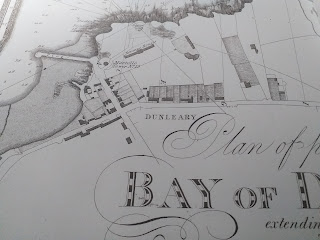The Martello towers of Dublin
Martello towers
Sandycove Martello tower featured in the opening chapter of Ulysses
Twenty six Martello towers were built in Dublin between 1804 -05 from Bray to Ballbriggan, the reason behind the building of these towers is due to the serious threat of invasion from Napoleon Bonaparte the French army of 2.5 million eclipsed that of the British army ( Royal navy ) The origin of the Martello towers were inspired by the coastal tower at Cape Mortello in Corsica dating back to the mid 16th century.
Cape Mortella, San Firenza Bay, Corsica © Mark Prokop
Dublin at the beginning of the 19th century was one of the least defended places in Ireland , Dublin was vulnerable to invasion . after the act of union in 1801 money was made available for coastal defences. On June 2nd 1804 , Lieutenant Colonel Benjamin Fisher was authorised to begin the construction of the 26 Martello towers to protect the city of Dublin.
Private contractors were used to build the towers, the south towers were built of granite the bedrock of south Dublin , the north towers were build with a mixture of different stone mixed with lime. Construction coasts were estimated at £1,800 per tower, the size of the towers were 7.3 metres high and 12 meters in diameter but towers at Dalkey , Williamstown , Sandymount and Ireland's eye had different dimensions and were known as double towers .
Talk at Williamstown Martello tower 22nd December 2021
Illustration of the interior of a tower .
https://martellotowers.co.uk/design
The interior of the towers were layout as follows , entry was by ladder which was approximately 10 feet from the base, the basement consisted of a storeroom where ammunition and water and provisions were kept.. there would have been bunks for 12 to 16 artillerymen stationed in the tower. A trapdoor was used to transfer ammunition and goods between floors . a spiral staircase was used to access the roof where a 360 degree gun platform was in position , this was the most important part of the tower. Another important part of the roof was the flagpole where messages were exchanged between towers.
Illustration of first floor of a Martello tower .
Illustration of Gun platform of a Martello tower .
The Martello towers and batteries of Dublin were manned by the Royal Artillery from Islandbridge barracks who were trained at Royal military academy at Woolwich who were answerable to the Board of ordnance.
Napoleonic wars ended with the defeat of Napoleon at the battle of Waterloo on 18th June 1815 and a peace treaty was signed between France and the United Kingdom , the towers became redundant artillerymen were stood down and redeployed elsewhere and the towers were mothballed .
Map of the sites of the 16 original Martello Towers and gun batteries between Bray and Sandymount and their 1600m arcs of fire. Built from September 1804 to February 1805 to defend Dublin from French invasion they formed a closely knit cohesive and formidable defensive barrier.
A noticeable difference with the towers on the Northside of Dublin are the distance between them 12 towers in total .
A book i highly recommand is The Martello towers of Dublin by Jason Bolton , Tim Carey , Rob Goodbody and Gerry Clabby .
Lost towers
Tower number one on Bray beach it was the first tower to be built and was disarmed in 1825 , the tower was built on a stormy beach and its foundations were undermined and structural damage was evident , a decision was made by the Bray town commissioners to demolish the tower in 1880 and stone was repurposed in the building of the sea wall as part of the new esplanade.
The Croke abbey tower ( number 3 ) was built to defend the entrance to the River Dargle and surrounding shoreline , a severe storm in October 1864 damaged the foundations and the occupants of the tower vacated it. the following year the entire eastern side fell into the sea on October 13th and remainder collapsed on 8th December 1865 the stones were used in the building of Bray auxiliary hospital on lower dargle .
The Maghera point Martello tower ( tower number 4 ) Shankill was located at the end of Quinn's road, near where the remaining railway bridge is now, by the end of the 19th century coastal erosion had damaged the cliffs at Maghera point which endangered the tower. the tower was demolished in 1912
Maghera point Martello tower Shankill Photo late 19th century.
Another lost tower was located in what is now the people park Dun laoghaire which included a gun battery the tower was similar in design to the Seapoint tower and is illustrated in a William Duncan's 1821 map of Dublin. the tower was disarmed in 1825, by 1854 the tower was redundant in use and purchased by the commissioners for Kingstown harbour and demolished.
William duncan's 1821 map depicting the Glasthule tower ( tower 12 )
Due to the extension of the Dublin and Kingstown railway, the Dunleary tower and battery the board of ordnance sold the tower ( 13 ) and battery for £ 1,700 to the commissioners of public works to enable the completion of the line in 1836.
Film i made last March at the location of the former Martello and Battery .

















Comments
Post a Comment